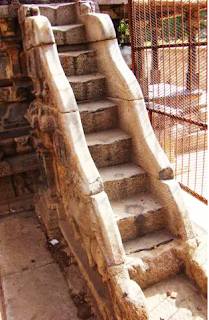Thank you for all the love and support for the first 2 parts. Tooke me time to write this blog and all your comments and love, makes it rewarding :)
Day 2 afternoon - after having a great lunch, we relaxed for a while in the resort and started @3.30PM to Airavateesvara Temple in Darasuram (On hindsight should have started at 2PM). It is just 80kms from Tanjore but the roads are narrow and hence took about 75 minutes.
This temple is a must-see if you are a fan of Chozha's architecture.
Dating back to the 12th Century, this architectural marvel
was built by the famous Chola King Rajaraja Chola II, dedicated to Lord Shiva.
It was much bigger than what it is now with the gopurams entirely in ruins, but
the main shrine and the associated sanctums still stand mighty and proud.
This temple was named after Airavat, Lord Indra’s white
elephant. Legend has it that the elephant was cursed by Sage Durvasa for
disrespecting Him which caused the spotless white elephant lose his colour. The
elephant prayed Lord Shiva, who asked him to take a dip in the temple tank and he
regained his white colour, freed from his curse (inscriptions narrating this is
in the inner sanctum of the temple). The devotees believe that taking a dip in
the temple tank will free them from their sins.
Temple timings: 8AM - 12 Noon, 4PM - 8PM
Pallippadai in Tamil
denotes a Memorial Temple, a place, as per Saivite rituals, where the ashes of
the person were buried, and a deity for worship- a Shiva Lingam -would be
consecrated. Generally built in honour of the loved one.
Panchavanmadevi was a Pazhuvettaraiyar Princess, a great dancer (legend has it that she posed for the Bharatanatya karanas in the Tanjore temple) and an eminent Patron of several temples. Several inscriptions mention her contributions.
During the Chola reign, it is a well documented fact that the women were empowered (We had a great civilisation even 1000 years ago!). Be it Kundhavai or Sembian madhevi or Panchavan Madhevi - they all were eminent personalities, well respected and contributed equally to the society at large.
What makes Panchavan Madhevi exceptional, to have a pallipadai in her honour, is that her immense affection for her step-son Rajendra I.
You can get the key from the temple priest, if it is closed. The people in the village are very cordial and will guide you to the priest's home.
The inscriptions are in adhistanam. The inscription reads:
You have to read Udayar to just understand Panchavan Madevi. You will just live with her, love her and breathe her. That feeling cannot be explained in words! It was really a dream come true moment for me to visit these places, to just breathe the same air they breathed 1000 years ago, to just walk in the same land they walked in.. it is just goosebumps moment for me!
Love you RRC, Kundhavai, Vandhiya thevan, Panchavan madevi, Rajendra Chozhan, Aniruddha brahmarayar, karuvur thevar, Easana siva pandithar, pazhuvettarayar and all those who contributed for the greatness we see today! My heart is just filled with varied emotions!
Priest Sabapathy Gurukkal: 9944664144
With a heavy heart, we
started to our next important stop in our trip - "Raja Raja Chozha's
pallipadai". Having seen Panchavan Madevi's and with so much of emotions
running in our mind, we were just silent and were not emotionally ready to meet
our King yet.
Google maps is crap,
kept taking us in circles, please call the priest, he will guide you.
Finally - we stepped on the land where the mighty King was buried. Where it all came to an end!
Udayalur village, ~32
kms from Thanjavur is where the great King was finally laid to rest.
Paalkulaththu Amman temple, located on the banks of Palkulam has a stone pillar
in its doorway bearing inscriptions. Previously this pillar was part of the
mandapam in Pazhayarai, where in the body of Raja Raja Cholan I laid for last
rites. At a later date this mandapam was demolished and the pillar was taken
and placed at Paalkulaththu Amman temple.
Here lies my mighty King
once expanded his kingdom within India and to south-asia, Srilanka, beyond
Indian Ocean; when crossing ocean was just a dream, leave alone having a
full-fledged navy and conquering far-off countries! Here lies the patron of art
who built architectural marvel Thanjavur temple! Here lies the sage who did the
unbelievable task of compiling "Thirumurai". Here lies the greatest
administrator who brought in so many civil reforms, who introduced elections,
assessment of land and reorganising them as valanadu. Above all, here lies a
great human being of all times! My Raja Raja Chozhan, Our Raja Raja Chozhan, Our
pride!
The final resting place
of the greatest Chola Emperor is in such a dilapidated condition that it just
broke my heart. The priest is so good and does whatever he can from the limited
income he gets. Just stepping on that land and looking at the mausoleum will
teach us so many lessons in life!
Whenever you can, please
do visit and pay your respects to the greatest king. If you cannot visit,
please call the priest and donate whatever you can for the upkeep of this
historical place!
I do not have any more
words! With a heavy heart and teary eyes, we just left that place. Long Live
Cholas! Long Live Raja Raja Chozhan! Long Live Tamil!









































